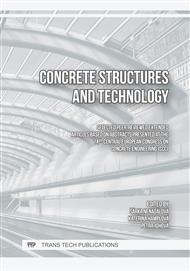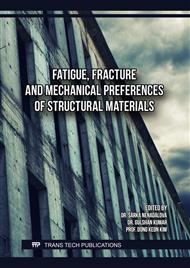[1]
K. Liu, J. Zheng, S. Dong, W. Xie, X. Zhang, Mixture optimization of mechanical, economical, and environmental objectives for sustainable recycled aggregate concrete based on machine learning and metaheuristic algorithms, Journal of Building Engineering. 63 (2023) 105570.
DOI: 10.1016/j.jobe.2022.105570
Google Scholar
[2]
S. Wang, P. Xia, F. Gong, Q. Zeng, K. Chen, Y. Zhao, Multi objective optimization of recycled aggregate concrete based on explainable machine learning, Journal of Cleaner Production. 445 (2024) 141045.
DOI: 10.1016/j.jclepro.2024.141045
Google Scholar
[3]
K. Rashid, M. U. Rehman, J. de Brito, H. Ghafoor, Multi-criteria optimization of recycled aggregate concrete mixes, Journal of Cleaner Production. 276 (2020) 124316.
DOI: 10.1016/j.jclepro.2020.124316
Google Scholar
[4]
K. C. Onyelowe, D. P. N. Kontoni, A. M. Ebid, F. Dabbaghi, A. Soleymani, H. Jahangir, M. L. Nehdi, Multi-objective optimization of sustainable concrete containing fly ash based on environmental and mechanical considerations, Buildings. 948 (2022) 1-25.
DOI: 10.3390/buildings12070948
Google Scholar
[5]
J. Zhang, Y. Huang, G. Ma, B. Nener, Mixture optimization for environmental, economical and mechanical objectives in silica fume concrete: A novel frame-work based on machine learning and a new meta-heuristic algorithm, Resources, Conservation and Recycling. 167 (2021) 105395.
DOI: 10.1016/j.resconrec.2021.105395
Google Scholar
[6]
K. A. Knight, P. R. Cunningham, S. A. Miller, Optimizing supplementary cementitious material replacement to minimize the environmental impacts of concrete, Cement and Concrete Composites. 139 (2023) 105049.
DOI: 10.1016/j.cemconcomp.2023.105049
Google Scholar
[7]
Y. S. Wang, H. K. Cho, X. Y. Wang, Mixture optimization of sustainable concrete with silica fume considering CO2 emissions and cost, Buildings. 12 (2022) 1580.
DOI: 10.3390/buildings12101580
Google Scholar
[8]
T. García-Segura, V. Yepes, Multiobjective optimization of post-tensioned concrete box-girder road bridges considering cost, CO2 emissions, and safety, Engineering Structures. 125 (2016) 325-336.
DOI: 10.1016/j.engstruct.2016.07.012
Google Scholar
[9]
S. Eleftheriadis, P. Duffour, P. Greening, J. James, B. Stephensone, D. Mumovic, Investigating relationships between cost and CO2 emissions in reinforced concrete structures using a BIM-based design optimisation approach, Energy & Buildings. 166 (2018) 330-346.
DOI: 10.1016/j.enbuild.2018.01.059
Google Scholar
[10]
X. Zhang, X. Zhang, Sustainable design of reinforced concrete structural members using embodied carbon emission and cost optimization, Journal of Building Engineering. 44 (2021) 102940.
DOI: 10.1016/j.jobe.2021.102940
Google Scholar
[11]
A. Kanyilmaz, P. R. N. Tichell, D. Loiacono, A genetic algorithm tool for conceptual structural design with cost and embodied carbon optimization, Engineering Applications of Artificial Intelligence. 112 (2022) 104711.
DOI: 10.1016/j.engappai.2022.104711
Google Scholar
[12]
S. H. Lee, B. K. Oh, J. Choi, D. H. Hong a , T. Hong, D. E. Lee, H. S. Park, Eco-friendly and economically optimal design model (EEODM) to reduce the CO2 emissions and the cost of long-span waffle slabs, Journal of Cleaner Production. 296 (2021) 126367.
DOI: 10.1016/j.jclepro.2021.126367
Google Scholar
[13]
X. Zhang, X. Zhang, Sustainable design of reinforced concrete structural members using embodied carbon emission and cost optimization, Journal of Building Engineering. 44 (2021) 102940.
DOI: 10.1016/j.jobe.2021.102940
Google Scholar
[14]
A. E. Kayabekir, Z. A. Arama, G. Bekda, S. M. Nigdeli, Z. W. Geem, Eco-friendly design of reinforced concrete retaining walls: Multi-objective optimization with harmony search applications, Sustainability. 12 (2020) 6087.
DOI: 10.3390/su12156087
Google Scholar
[15]
E. Fraile-Garciaa, J. Ferreiro-Cabellob, E. Martinez-Camarac, E. Jimenez-Maciasd, Optimization based on life cycle analysis for reinforced concrete structures with one-way slabs, Engineering Structures. 109 (2016) 126-138.
DOI: 10.1016/j.engstruct.2015.12.001
Google Scholar
[16]
L. Kumi, J. Jeong, Optimization model for selecting optimal prefabricated column design considering environmental impacts and costs using genetic algorithm, Journal of Cleaner Production. 417 (2023) 137995.
DOI: 10.1016/j.jclepro.2023.137995
Google Scholar
[17]
PREFA PRAHA [online]. Spiroll ceiling plates © 2024 [cit. 12.8.2024]. Available: https://www.prefa-praha.cz/en/spirolly-2/.
Google Scholar
[18]
A. Horáková, Optimization of concrete structures in terms of environmental impacts and durability, Doctoral Thesis, Czech Technical University in Prague, Faculty of Civil Engineering, Praha, 2021.
Google Scholar
[19]
Z. Šmerda, Durability of reinforced concrete structures, Technical library of authorized engineer and technician, Praha, 1999.
Google Scholar
[20]
C. Bob, E. Afana, On-site assessment of concrete carbonation, Proceedings of the international RILEM conference "Failure of concrete structures, RILEM Publications SARL. (1993) 84–87.
Google Scholar
[21]
J. Rodriguez, L.M. Ortega, J. Casal, J.M. Diez, Corrosion of reinforcement and service life of concrete structures, Proceedings of International Conference on Durability of Building Materials and Components. 7 (1996) 117-126.
DOI: 10.4324/9781315025025-13
Google Scholar
[22]
A. Poursaee, Potentiostatic transient technique, a simple approach to estimate the corrosion current density and Stern–Geary constant of reinforcing steel in concrete, Cement and Concrete Research. 40 (2010) 1451-1458.
DOI: 10.1016/j.cemconres.2010.04.006
Google Scholar
[23]
B. Teplý, D. Vořechovská, Asserting failure probability associated with degradation of concrete structures, The FESI Bulletin. 8 (2014) 15-19.
Google Scholar
[24]
S. Morinaga, Predicition of service lives of reinforced concrete buildings based on the corrosion rate of reinforcing steel, Special Report No. 23, Institute of Technology, Tokyo: Shimizu Corporation, (1988) pp.5-16.
Google Scholar
[25]
CENIA database EPD CZ [online]. CENIA, The Czech Environmental Information Agency © 2024 [cit. 12.8.2024]. Available: https://www.cenia.cz/spolecenska-odpovednost/epd/ databaze-epd/.
Google Scholar



